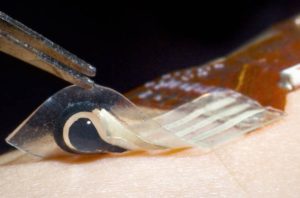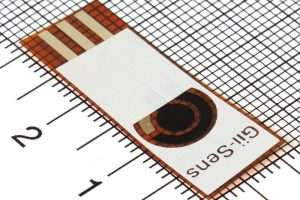
The chemicals are known as solid-state epidermal biomarkers.
“These biomarkers, which include cholesterol and lactate, are found in the stratum corneum, the outermost layer of the skin, and have shown strong correlations with diseases such as cardiovascular disease and diabetes,” according to the university. “However, detecting these biomarkers directly has been difficult. For instance, traditional solid electrodes lack the necessary charge transport pathways to enable electrochemical sensing of solid-state epidermal biomarkers.”
The screen-printed sensor consists of two hydrogel layers, the lower (skin facing) an ion-conducting gel, and the upper an electron conductor. Between the two is a layer of carefully-selected enzymes.
In use, the sensor patch is stuck onto the skin, where the biomarkers of interest dissolve into the lower (ion-conducting) hydrogel layer, then diffuse onward until they meet the enzymes and chemically react. Electrons liberated by the reactions can carry on thorough the electron-conducting hydrogel layer to be picked up by an electrode.
Solid lactate was detected down to 0.51nmol2 and solid cholesterol down to 0.26nmol/cm2, respectively.
The stretchable nature of the substrate and the gels allows the sensor to move with the skin, dramatically reducing motion artifacts.
“In a clinical study, solid-state epidermal biomarkers measured by our stretchable wearable sensors showed a high correlation with biomarkers in human blood and dynamically correlated with physiological activities,” according to Stretchable ionic–electronic bilayer hydrogel electronics enable in situ detection of solid-state epidermal biomarkers, a paper published by the team in Nature Materials.
The sensor is ‘used-up’ as it operates – the team is looking for ways to increasing working time as well increase sensitivity and the range of biomarkers detected.
 Electronics Weekly Electronics Design & Components Tech News
Electronics Weekly Electronics Design & Components Tech News



